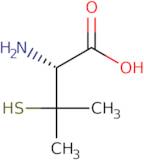L-Penicillamine
CAS: 1113-41-3
Ref. 3D-FP26793
| 1g | Descontinuado | ||
| 2g | Descontinuado | ||
| 5g | Descontinuado | ||
| 10g | Descontinuado | ||
| 25g | Descontinuado |
Informação sobre produto
- H-Pen-OH
- (+)-Penicillamine
- (2R)-2-Amino-3-methyl-3-sulfanylbutanoic acid
- (R)-2-Amino-3-mercapto-3-methylbutanoic acid
- (R)-Penicillamine
- 1113-41-3
- 3-Mercapto-<span class="text-smallcaps">L</span>-valine
- 3-Sulfanylvaline
- 3-sulfanyl-L-valine
- <span class="text-smallcaps">L</span>-Penicillamine
- Ver mais sinónimos
- <span class="text-smallcaps">L</span>-Valine, 3-mercapto-
- Alpha-Amino-Beta-Methyl-Beta-Mercaptobutyric Acid
- NSC 241261
- Valine, 3-Mercapto-
- Valine, 3-mercapto-, <span class="text-smallcaps">L</span>-
- 3-Mercapto-L-valine
- Valine, 3-mercapto-, L-
- L-Valine, 3-mercapto-
L-Penicillamine is a drug that is used to treat Wilson's disease and other types of copper poisoning. It binds to copper ions in the body, preventing them from being absorbed by tissues. L-Penicillamine also has an inhibitory effect on mesenteric lymph nodes and prevents the release of inflammatory mediators. This drug was shown to have a chemical stability of more than 24 hours in human serum at pH 7.4 and 37°C, as well as an enantiomeric purity of 99%. The main metabolic pathway for L-penicillamine is hydrolysis by the action of enzymes that contain metal-binding groups such as cysteine or lysine residues, although some metabolism may occur via esterases. One example is streptococcus faecalis, which can produce pencillinase that hydrolyzes penicillin derivatives with a carbonyl group, like L-penicillamine.





